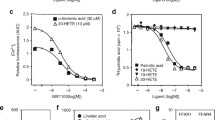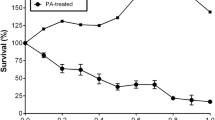Abstract
Free fatty acids (FFA) have generally been proposed to regulate pancreatic insulin release by an intracellular mechanism involving inhibition of CPT-1. The recently de-orphanized G-protein coupled receptor, FFA1R/GPR40, has been shown to be essential for fatty-acid-stimulated insulin release in MIN6 mouse insulinoma cells. The CPT-1 inhibitor, 2-bromo palmitate (2BrP), was investigated for its ability to interact with mouse FFA1R/GPR40. It was found to inhibit phosphatidyl inositol hydrolysis induced by linoleic acid (LA) (100 μM in all experiments) in HEK293 cells transfected with FFA1R/GPR40 and in the MIN6 subclone, MIN6c4. 2BrP also inhibited LA-stimulated insulin release from mouse pancreatic islets. Mouse islets were subjected to antisense intervention by treatment with a FFA1R/GPR40-specific morpholino oligonucleotide for 48 h. Antisense treatment of islets suppressed LA-stimulated insulin release by 50% and by almost 100% when islets were pretreated with LA for 30 min before applying the antisense. Antisense treatment had no effect on tolbutamide-stimulated insulin release. Confocal microscopy using an FFA1R/GPR40-specific antibody revealed receptor expression largely localized to the plasma membrane of insulin-producing cells. Pretreating the islets with LA for 30 min followed by antisense oligonucleotide treatment for 48 h reduced the FFA1R/GPR40 immunoreactivity to background levels. The results demonstrate that FFA1R/GPR40 is inhibited by the CPT-1 inhibitor, 2BrP, and confirm that FFA1R/GPR40 is indeed necessary, at least in part, for fatty-acid-stimulated insulin release.







Similar content being viewed by others
References
Antinozzi PA, Segall L, Prentki M, McGarry JD, Newgard CB (1998) Molecular or pharmacologic perturbation of the link between glucose and lipid metabolism is without effect on glucose-stimulated insulin secretion. A re-evaluation of the long-chain acyl-CoA hypothesis. J Biol Chem 273:16146–16154
Bollheimer LC, Skelly RH, Chester MW, McGarry JD, Rhodes CJ (1998) Chronic exposure to free fatty acid reduces pancreatic beta cell insulin content by increasing basal insulin secretion that is not compensated for by a corresponding increase in proinsulin biosynthesis translation. J Clin Invest 101:1094–1101
Briscoe CP, Tadayyon M, Andrews JL, Benson WG, Chambers JK, Eilert MM, Ellis C, Elshourbagy NA, Goetz AS, Minnick DT, Murdock PR, Sauls HR Jr, Shabon U, Spinage LD, Strum JC, Szekeres PG, Tan KB, Way JM, Ignar DM, Wilson S, Muir AI (2003) The orphan G protein-coupled receptor GPR40 is activated by medium and long chain fatty acids. J Biol Chem 278:11303–11311
Chase JF, Tubbs PK (1972) Specific inhibition of mitochondrial fatty acid oxidation by 2-bromopalmitate and its coenzyme A and carnitine esters. Biochem J 129:55–65
Chen S, Ogawa A, Ohneda M, Unger RH, Foster DW, McGarry JD (1994) More direct evidence for a malonyl-CoA-carnitine palmitoyltransferase I interaction as a key event in pancreatic beta-cell signaling. Diabetes 43:878–883
Corkey BE, Deeney JT, Yaney GC, Tornheim K, Prentki M (2000) The role of long-chain fatty acyl-CoA esters in beta-cell signal transduction. J Nutr 130:299S–304S
Deeney JT, Gromada J, Hoy M, Olsen HL, Rhodes CJ, Prentki M, Berggren PO, Corkey BE (2000) Acute stimulation with long chain acyl-CoA enhances exocytosis in insulin-secreting cells (HIT T-15 and NMRI beta-cells) J Biol Chem 275:9363–9368
Dobbins RL, Chester MW, Daniels MB, McGarry JD, Stein DT (1998a) Circulating fatty acids are essential for efficient glucose-stimulated insulin secretion after prolonged fasting in humans. Diabetes 47:1613–1618
Dobbins RL, Chester MW, Stevenson BE, Daniels MB, Stein DT, McGarry JD (1998b) A fatty acid- dependent step is critically important for both glucose- and non-glucose-stimulated insulin secretion. J Clin Invest 101:2370–2376
Fatehi-Hassanabad Z, Chan CB (2005) Transcriptional regulation of lipid metabolism by fatty acids: a key determinant of pancreatic beta-cell function. Nutr Metab (Lond) 2:1
Gaborik Z, Hunyady L (2004) Intracellular trafficking of hormone receptors. Trends Endocrinol Metab 15:286–293
Gotoh M, Maki T, Kiyoizumi T, Satomi S, Monaco AP (1985) An improved method for isolation of mouse pancreatic islets. Transplantation 40:437–438
Haber EP, Ximenes HM, Procopio J, Carvalho CR, Curi R, Carpinelli AR (2003) Pleiotropic effects of fatty acids on pancreatic beta-cells. J Cell Physiol 194:1–12
Heasman J (2002) Morpholino oligos: making sense of antisense? Dev Biol 243:209–214
Itoh Y, Kawamata Y, Harada M, Kobayashi M, Fujii R, Fukusumi S, Ogi K, Hosoya M, Tanaka Y, Uejima H, Tanaka H, Maruyama M, Satoh R, Okubo S, Kizawa H, Komatsu H, Matsumura F, Noguchi Y, Shinohara T, Hinuma S, Fujisawa Y, Fujino M (2003) Free fatty acids regulate insulin secretion from pancreatic beta cells through GPR40. Nature 422:173–176
Kang DS, Leeb-Lundberg LM (2002) Negative and positive regulatory epitopes in the C-terminal domains of the human B1 and B2 bradykinin receptor subtypes determine receptor coupling efficacy to G(q/11)-mediated [correction of G(9/11)-mediated] phospholipase Cbeta activity. Mol Pharmacol 62:281–288
Kenakin T (1997) Differences between natural and recombinant G protein-coupled receptor systems with varying receptor/G protein stoichiometry. Trends Pharmacol Sci 18:456–464
Kotarsky K, Antonsson L, Owman C, Olde B (2003a) Optimized reporter gene assays based on a synthetic multifunctional promoter and a secreted luciferase. Anal Biochem 316:208–215
Kotarsky K, Nilsson NE, Flodgren E, Owman C, Olde B (2003b) A human cell surface receptor activated by free fatty acids and thiazolidinedione drugs. Biochem Biophys Res Commun 301:406–410
Lefkowitz RJ (2004) Historical review: a brief history and personal retrospective of seven-transmembrane receptors. Trends Pharmacol Sci 25:413–422
Lei Q, Jones MB, Talley EM, Garrison JC, Bayliss DA (2003) Molecular mechanisms mediating inhibition of G protein-coupled inwardly-rectifying K+ channels. Mol Cells 15:1–9
Miyazaki J, Araki K, Yamato E, Ikegami H, Asano T, Shibasaki Y, Oka Y, Yamamura K (1990) Establishment of a pancreatic beta cell line that retains glucose-inducible insulin secretion: special reference to expression of glucose transporter isoforms. Endocrinology 127:126–132
Olofsson CS, Salehi A, Holm C, Rorsman P (2004) Palmitate increases L-type Ca2+ currents and the size of the readily releasable granule pool in mouse pancreatic beta-cells. J Physiol 557:935–948
Parker SM, Moore PC, Johnson LM, Poitout V (2003) Palmitate potentiation of glucose-induced insulin release: a study using 2-bromopalmitate. Metabolism 52:1367–1371
Poitout V (2003) The ins and outs of fatty acids on the pancreatic beta cell. Trends Endocrinol Metab 14:201–203
Prentki M, Vischer S, Glennon MC, Regazzi R, Deeney JT, Corkey BE (1992) Malonyl-CoA and long chain acyl-CoA esters as metabolic coupling factors in nutrient-induced insulin secretion. J Biol Chem 267:5802–5810
Proks P, Reimann F, Green N, Gribble F, Ashcroft F (2002) Sulfonylurea stimulation of insulin secretion. Diabetes Suppl 3
Remizov O, Jakubov R, Dufer M, Krippeit Drews P, Drews G, Waring M, Brabant G, Wienbergen A, Rustenbeck I, Schofl C (2003) Palmitate-induced Ca2+-signaling in pancreatic beta-cells. Mol Cell Endocrinol 212:1–9
Robertson RP, Harmon J, Tran PO, Poitout V (2004) Beta-cell glucose toxicity, lipotoxicity, and chronic oxidative stress in type 2 diabetes. Diabetes 53(Suppl 1):S119–S124
Salehi A, Ekelund M, Henningsson R, Lundquist I (2001) Total parenteral nutrition modulates hormone release by stimulating expression and activity of inducible nitric oxide synthase in rat pancreatic islets. Endocrine 16:97–104
Salehi A, Ekelund M, Lundquist I (2003) Total parenteral nutrition-stimulated activity of inducible nitric oxide synthase in rat pancreatic islets is suppressed by glucagon-like peptide-1. Horm Metab Res 35:48–54
Scholze A, Plant TD, Dolphin AC, Nurnberg B (2001) Functional expression and characterization of a voltage-gated CaV1.3 (alpha1D) calcium channel subunit from an insulin-secreting cell line. Mol Endocrinol 15:1211–1221
Smith PA, Sellers LA, Humphrey PP (2001) Somatostatin activates two types of inwardly rectifying K+ channels in MIN-6 cells. J Physiol 532:127–142
Spector AA, Fletcher JE, Ashbrook JD (1971) Analysis of long-chain free fatty acid binding to bovine serum albumin by determination of stepwise equilibrium constants. Biochemistry 10:3229–3232
Warnotte C, Gilon P, Nenquin M, Henquin JC (1994) Mechanisms of the stimulation of insulin release by saturated fatty acids. A study of palmitate effects in mouse beta-cells. Diabetes 43:703–711
Vaughn J, Wolford JK, Prochazka M, Permana PA (2000) Genomic structure and expression of human KCNJ9 (Kir3.3/GIRK3) Biochem Biophys Res Commun 274:302–309
Yaney GC, Korchak HM, Corkey BE (2000) Long-chain acyl CoA regulation of protein kinase C and fatty acid potentiation of glucose-stimulated insulin secretion in clonal beta-cells. Endocrinology 141:1989–1998
Yonezawa T, Katoh K, Obara Y (2004) Existence of GPR40 functioning in a human breast cancer cell line, MCF-7. Biochem Biophys Res Commun 314:805–809
Acknowledgements
The technical help of Britt-Marie Nilsson is greatly appreciated. We also thank professor Patrik Rorsman for making available the confocal microscope. This work was supported in part by grants from the Swedish Segerfalk Foundation, GS Development, Crafoord Foundation, Kock Foundation, Royal Physiographic Society, Lund, The Swedish Diabetes Foundation, The Diabetes Programme at the Medical Faculty of Lund University, and the Swedish National Council for Medical Research.
Author information
Authors and Affiliations
Corresponding author
Additional information
A. Salehi and E. Flodgren contributed equally to this work
Rights and permissions
About this article
Cite this article
Salehi, A., Flodgren, E., Nilsson, N.E. et al. Free fatty acid receptor 1 (FFA1R/GPR40) and its involvement in fatty-acid-stimulated insulin secretion. Cell Tissue Res 322, 207–215 (2005). https://doi.org/10.1007/s00441-005-0017-z
Received:
Accepted:
Published:
Issue Date:
DOI: https://doi.org/10.1007/s00441-005-0017-z




